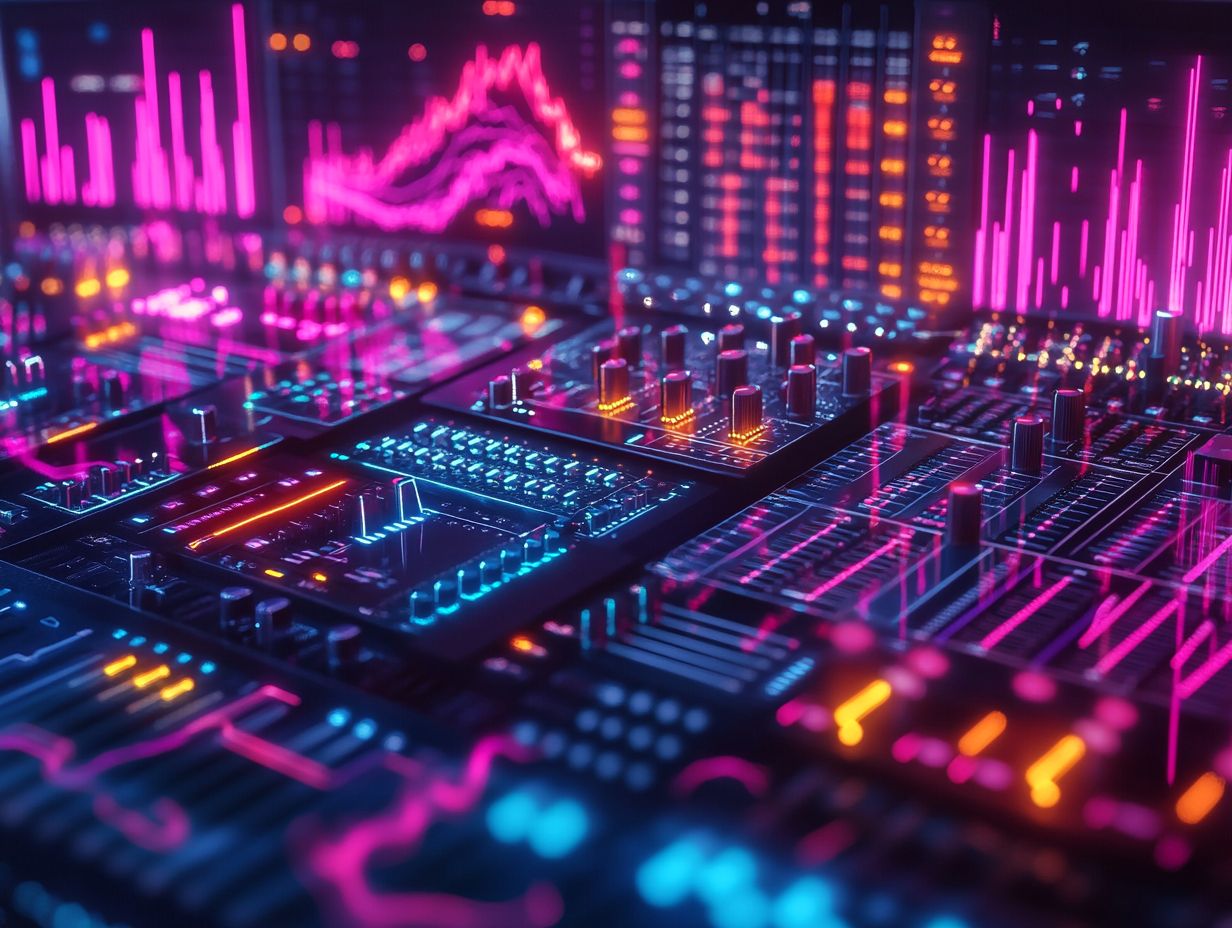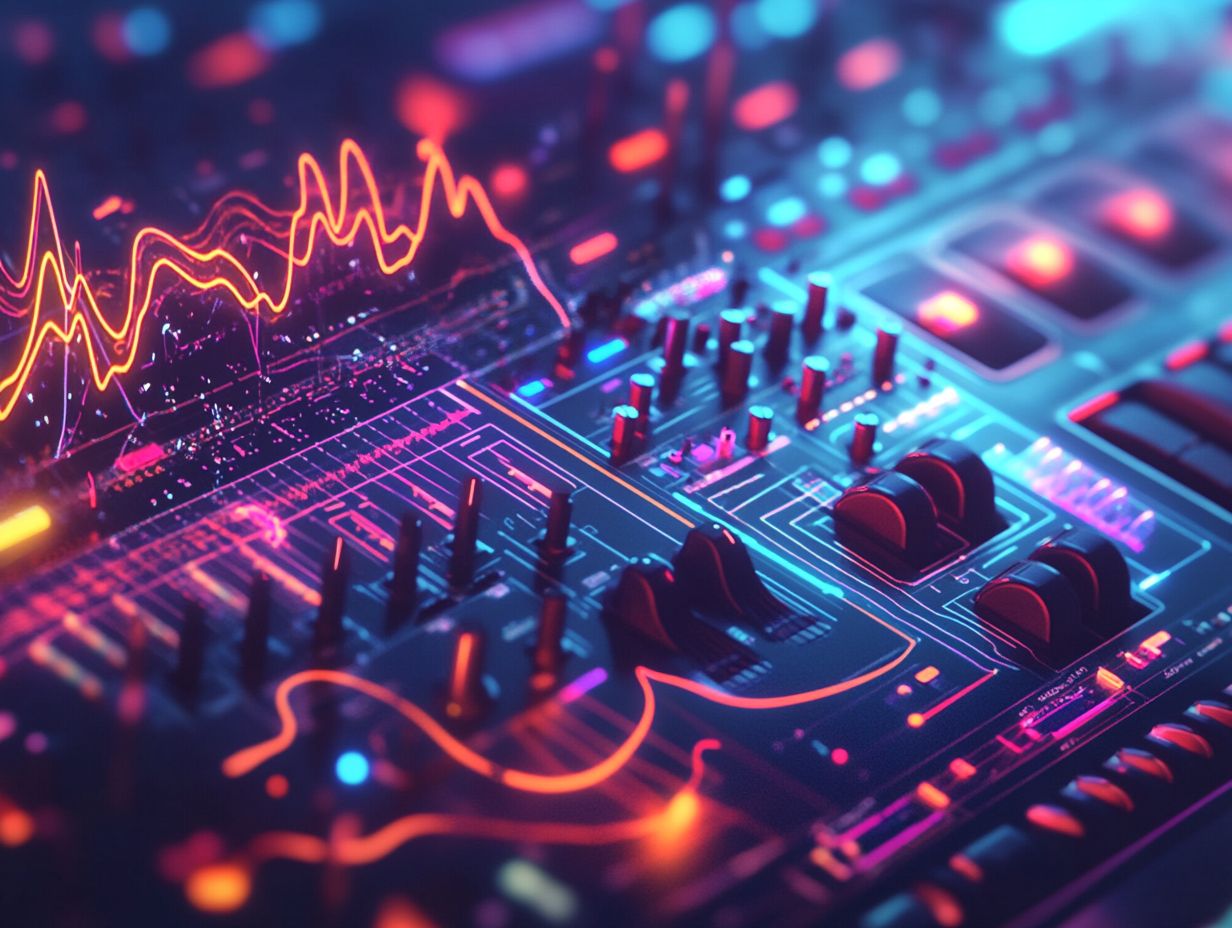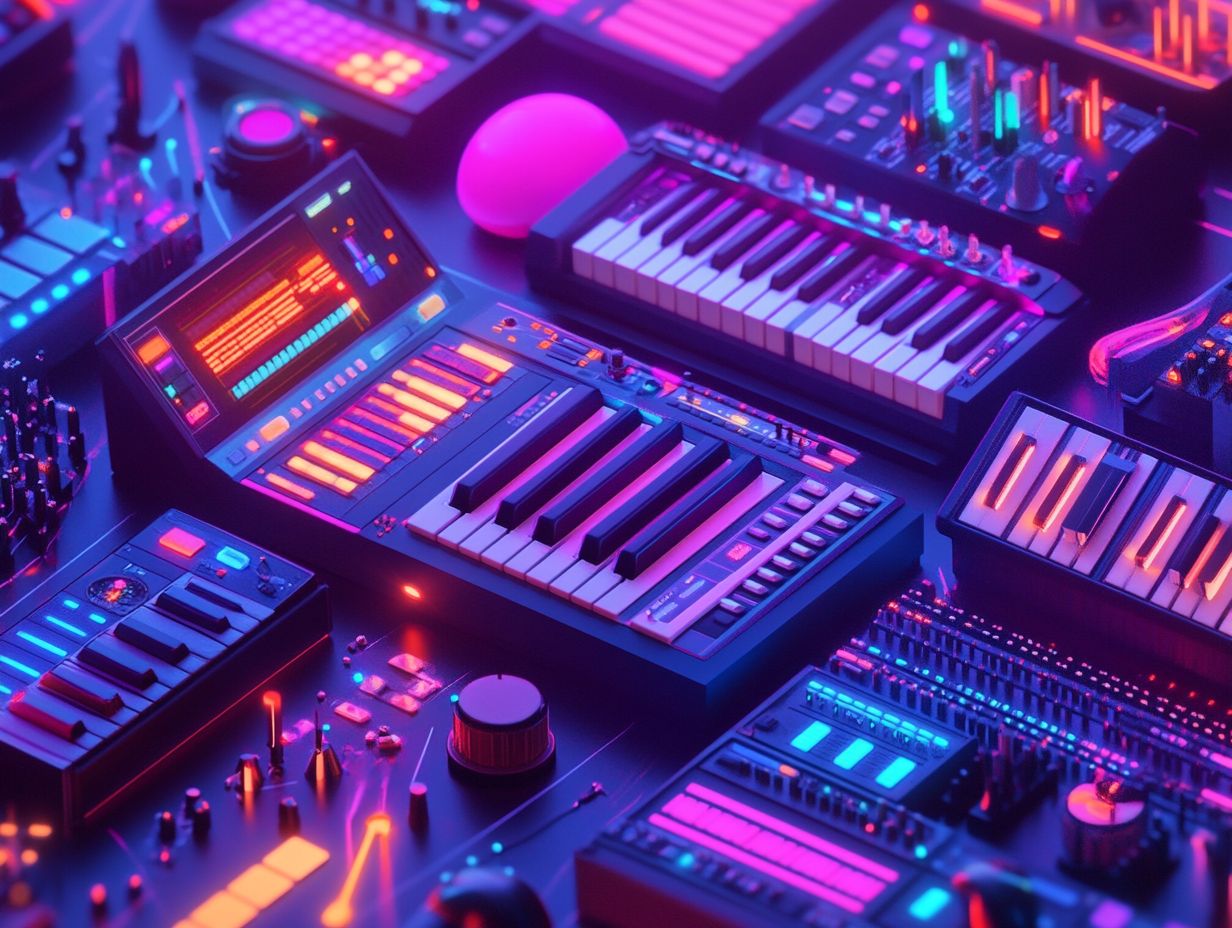Synthesizers have revolutionized the landscape of electronic music, fundamentally changing how artists create and express sound.
From the early days of analog devices to the advanced digital instruments of today, synthesizers have played a pivotal role in shaping various genres, styles, and trends.
This piece explores the evolution of these fascinating instruments, compares different types, and highlights techniques for harnessing their full potential.
Additionally, it showcases influential artists who have made significant contributions to the genre and the signature sounds that define the world of electronic music.
Contents
What are Synthesizers?

Synthesizers are electronic musical instruments that generate audio signals and play a vital role in the world of electronic music. They utilize audio synthesis, modulation, and sampling techniques to produce a wide range of sounds. Synthesizers incorporate components such as oscillators, which create raw waveforms, and filters, which shape these waveforms and textures. With this diverse toolkit, musicians can explore the vast possibilities that synthesizers offer in sound design and music production.
Synthesizers can be classified into several categories, including analog, digital, and modular synthesizers, based on their sound production methods. Analog synthesizers generate raw waveforms as electrical voltages, which are then converted into sound waves by voltage-controlled oscillators (VCOs). Digital synthesizers, on the other hand, use mathematical equations to create sounds. Modular synthesizers consist of independent modules that musicians can connect, allowing for the creation of custom signal paths.
Regardless of their type, synthesizers remain essential tools in music production and the exploration of new sound creation. They are used by pop producers to craft catchy melodies and by sound designers to create immersive atmospheres for film.
The Evolution of Electronic Music
The evolution of electronic music is a rich tapestry woven from diverse cultural influences and experimentation, resulting in the emergence of distinct genres such as techno, house music, and ambient music.
Over the decades, technological advancements and innovative practices—such as audio synthesis and sound manipulation—have transformed how musicians create and experience music, paving the way for future developments that push artistic boundaries.
From Analog to Digital
The transition from analog to digital synthesizers marked a significant milestone in music production, revolutionizing sound design and offering unprecedented audio fidelity and versatility.
While analog synthesizers relied on voltage-controlled oscillators and complex circuitry to generate sound, digital synthesizers utilize advanced signal processing algorithms and sampling techniques to create a wide range of sounds and textures. This evolution not only expanded the sonic palette available to musicians but also introduced new methods for composition and sound manipulation.
Analog synthesizers are often celebrated for their warm, rich tones, which are characterized by harmonic complexity and believed by many artists to add a human touch to their music. In contrast, digital synthesizers offer remarkable precision and repeatability, enabling composers to achieve sounds that would be incredibly challenging or impossible to create with analog technology.
This shift has had profound implications for genres such as electronic music, pop, and film scoring, where detailed sound design can significantly enhance the immersive auditory experience.
The Role of Synthesizers in Electronic Music

Synthesizers play a crucial role in electronic music, as they provide artists with a versatile means of sound creation and manipulation. This versatility enables the development of intricate soundscapes and experimental music compositions.
The ability to generate a wide range of pure tones and utilize various synthesis techniques, such as subtractive and additive synthesis, allows for the creation of numerous virtual instruments. These capabilities are extensively explored in both studio and live performance settings.
How Synthesizers Changed the Game
Synthesizers play a crucial role in music technology as they are instruments that allow for the manipulation of audio and control parameters through production techniques such as patching, modulation, and effect processing. These techniques have introduced new dimensions to musical expression and audio engineering that were previously unattainable, significantly expanding the creative possibilities for music composition and arrangement.
Additionally, synthesizers have the unique ability to create distinct tones and textures, transforming genres such as electronic dance music, rock, pop, and even jazz. These electronic instruments enable artists to explore unconventional soundscapes that challenge traditional boundaries and inspire innovation.
With a diverse array of types—from analog to digital—synthesizers offer a wide-ranging palette for sound designers and composers, allowing them to create intricate soundtracks or energizing tracks that captivate listeners. Moreover, synthesizers have played a key role in the rise of home recording studios, give the power toing aspiring musicians to produce high-quality tracks independently and forever changing the music landscape.
Types of Synthesizers
The various types of synthesizers include:
- hardware synthesizers
- software synthesizers
- modular synthesizers
- virtual analog synthesizers
- additive synthesizers
- granular synthesizers
- sample-based synthesizers
Analog vs. Digital Synthesizers

Analog synthesizers are renowned for their warm, rich sounds, which are produced through voltage-controlled components. In contrast, digital synthesizers offer precision and versatility by employing advanced algorithms to manipulate waveforms. This distinction highlights the fundamental differences in sound design approaches: analog synthesizers evoke nostalgia and character, while digital synthesizers provide a vast array of sonic possibilities and high audio fidelity.
In essence, analog synthesizers impart a unique, organic timbre that many music producers and sound designers favor for genres such as synthwave and ambient music. Their continuous waveforms can create subtle imperfections, contributing to a lush character that feels alive. Conversely, digital synthesizers excel in functionality, as they can accurately reproduce complex sounds and support intricate sound layering, which is invaluable in contemporary productions.
While analog models may lack the flexibility of their digital counterparts—often constrained by their physical circuitry—digital synthesizers can replicate analog sounds, though they sometimes miss the warmth associated with true analog synthesis. This ongoing contrast ensures that each type remains relevant for different applications, with analog dominating in traditional recordings while digital shines in film scoring and electronic dance music.
Modular vs. Non-Modular Synthesizers
Modular synthesizers provide a unique hands-on experience, allowing users to customize their sound architecture through patching. In contrast, non-modular synthesizers offer a more streamlined approach for quick sound creation. This distinction emphasizes the varying levels of creativity and experimentation available in the synthesis process.
Modular units encourage exploration and deep sound manipulation, while non-modular designs prioritize accessibility and ease of use. The modular design philosophy inspires artists to think outside the box and sculpt their sonic landscapes in intricate and often unexpected ways. Each module serves a specific function, fostering interactivity that can lead to serendipitous sound discoveries.
Conversely, non-modular synthesizers come equipped with preset sounds that can be easily adjusted, making them ideal for those who value straightforward workflows and immediate results. Although non-modular units may limit the depth of sound exploration, their stability and reliability make them appealing for live performances.
Ultimately, the choice between modular and non-modular synthesizers can significantly influence an artist’s creative journey and sonic identity.
Creating Electronic Music Landscapes with Synthesizers
Electronic music landscapes are crafted using synthesizers by layering sounds and timbres to create intricate musical environments. These landscapes are often enhanced through the use of effects processors, which sculpt rich audio experiences that characterize an artist’s distinctive sound.
Techniques and Tips

Here are some practical techniques for using synthesizers in sound design for electronic music.
Modulation with LFOs and Envelopes: Modulators like LFOs (low-frequency oscillators) and Envelopes (ADSR) can create motion in sound. LFOs can be routed to any parameter you wish to modulate, such as filter cutoff, oscillator pitch, and amplitude.
This technique is most effective with parameter values that are already fluctuating. For instance, if you route an LFO to pitch, you can achieve a slow upward modulation of the pitch value, combined with a rapid modulation around that point, resulting in a warbling effect. Envelopes are particularly useful for introducing dynamic movement within a sound, such as a gradual attack followed by a quick decay for percussion sounds.
Envelope parameters can also be modulated by an LFO, allowing for a scenario where the attack of a sound varies slowly while its volume changes rapidly. Additionally, modulating the volume of a sound can create effects like flanging or phasing, with the LFO modulating the filter frequency at a fast rate; this technique serves as the foundation for a wide variety of effects. Modulating parameters such as pitch, pulsation, and filtering can introduce depth and motion, making sounds feel more organic.
Filter Types: Low Pass (LP), High Pass (HP), Band Pass (BP), and Notch: Filters are another common method used in sound design. These include LP, HP, BP, and notch filters. Filters can reduce unwanted frequencies and also shape a sound’s character. For example, LP filters are often employed to diminish high frequencies in bass sounds. When designing sounds, it is essential to consider the type of sound being created and the frequency range of the notes involved. Utilizing filters in sound design can help achieve the desired character and tone while effectively reducing unnecessary frequencies.
Effect Types: Reverb, Delay, Chorus, Distortion/Overdrive, and Equalizers/Compressors: Effects are also vital techniques in sound design. Effects such as reverb and delay can add depth and space to a sound. For instance, reverb frequencies can be modulated with an LFO to create a sensation of movement through space. Similarly, modulating delay feedback levels can create a delay that feels dynamic and shifting. Adding distortion or overdrive can enhance the character of EDM sounds, while equalizers can help eliminate extraneous frequencies. Compression can be utilized to produce a more dynamic sound.
These foundational sound design techniques provide an excellent starting point for experimentation. Each technique is governed by its own mathematical functions that can be adjusted to create new sounds. Experimenting with these functions is key to discovering parameters that can be varied to generate innovative sounds. Sounds that convey a story are often not static; rather, they exhibit dynamic evolution and movement.
Famous Synthesizer Users and their Impact on Electronic Music
Renowned synthesizer users have significantly shaped the landscape of electronic music and driven innovation through their unique approaches and styles.
Artists such as Kraftwerk, Jean-Michel Jarre, and Daft Punk have expanded the boundaries of sound, influencing musicians across various genres with their sonic experimentation.
Influential Artists and their Signature Sounds
Influential artists in electronic music have developed signature sounds that showcase the creative potential of synthesizers, often defining the aesthetics of their respective genres. For example, the ethereal soundscapes of Brian Eno and the rhythmic complexity of Aphex Twin illustrate how synthesizers can be used to create lush textures and intricate audio experiences that resonate with listeners.
These artists have pushed the boundaries of electronic music, exploring the interplay between technology and human emotion. Their innovative use of synthesizers not only shapes their unique styles but also influences the broader landscape of contemporary music.
Kraftwerk’s pioneering work, for instance, laid the foundation for electronic pop by employing melodic lines produced by custom-built synthesizers to create catchy yet complex tracks. Similarly, the pulsating beats and atmospheric layers in Daft Punk’s music highlight the transformative capabilities of synthesizers in crafting infectious dance music that continues to define club culture today.
By integrating various electronic elements, these artists enrich their own compositions and inspire new generations to explore the limitless possibilities within the electronic genre.
